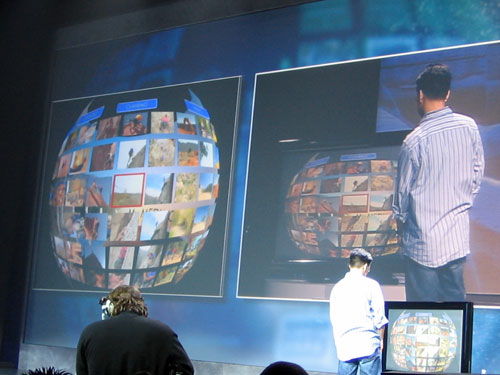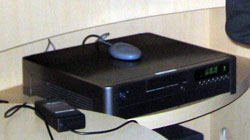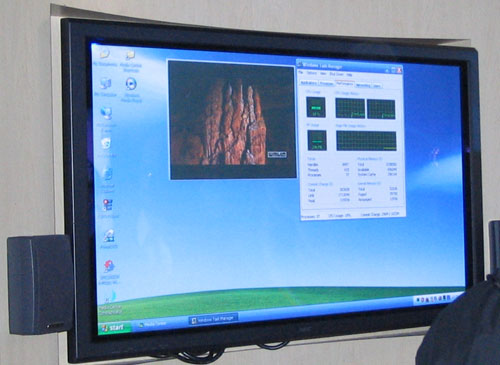Consumer Electronics Show 2005: AT's Coverage
by Anand Lal Shimpi on January 10, 2005 3:49 AM EST- Posted in
- Trade Shows
Dual Core at 3.0GHz - Working Now
Starting off with the PC side of things, Intel was far more present at CES than AMD, which is what we expected given the higher level of involvement from Intel on the CE front.
During Craig Barrett's keynote on the first day of CES, one of the demos involved a media center PC (not MCE) showcasing an interesting method of navigating video content on the PC: using hand gestures.

The spherical image on the left was basically your channel listing, with each one of those little windows displaying a full frame rate video stream, the sum of which was all of the channels you could possibly watch. You could rotate the channels left or right by moving your hands in the appropriate direction, and you could select which channel you wanted to watch by pointing at it. The demo wasn't flawless but Barrett promised that the technology being demoed was something that would be available 12 months from now.
Whether he was talking about every aspect of that particular PC or just its dual core Smithfield based processor is up to anyone's speculation. Unfortunately Barrett didn't disclose too much about the CPU specs of the system other than it was a dual core unit.

Intel's Dual Core Smithfield Pentium 4 x30 platform with both cores running at 3.0GHz
Luckily at Intel's booth we were able to get a glimpse of said system and found out it was a fully functional 90nm Smithfield running at 3.0GHz. It's about time Intel had a running dual core demo, it was beginning to look like only AMD would be able to pull off dual core.

Task Manager shows the two cores in action, note that there is no Hyper Threading on Dual Core CPUs so there are only two physical CPUs listed
Bring up of Intel's dual core seems to be pretty strong and everything is on track for a release at the end of 2005. We did get confirmation that the dual core CPUs would not work on existing 925X and 915 based motherboards, not without changes to their design. While we would normally be disappointed, the fact of the matter is that very few people bought 925X and 915 based motherboards so it's not too big of a deal.
We also asked Intel if they had any tricks up their sleeve for regaining the definitive performance crown this year - unfortunately their answer was no. It appears that a lot of upper management at Intel is a bit astounded by the success of Centrino, noting that it is a full blown success achieved on features and a full platform and not purely performance. There's also this idea that performance right now is good enough for most desktop users, and fighting over a handful of percentage points that won't be appreciated is a silly battle to win. So for the near future at least, it seems like what we've published in previous Intel roadmaps is all we're going to see from them. What remains to be seen is if AMD will be able to continue to convert Intel's lack of focus on absolute performance leadership into marketshare for AMD.
Intel also seems confident that dual core will bring noticeable performance gains to the desktop user, citing that while application support may not be there that the OS and multitasking experiences will be greatly improved to the point that once you've used dual core you'll never go back. Having personally used multiprocessor systems as my main workstations for years now I can attest to the benefits of multiprocessors, however more than anything we're going to need a good way of quantifying the performance benefits with something else than an Intel script that runs an antivirus scan while you defragment your hard drive.










48 Comments
View All Comments
sprockkets - Monday, January 10, 2005 - link
Forget using a DLP television, I want a DLP projector on a 100"+ screen.Oh well each has its advantages and disadvantages.
Better not have any stationary images on a plasma I've heard :)
snorre - Monday, January 10, 2005 - link
#23: Well, so you're telling me that the Inquirer are deceiving us then whey reported the following less then a month ago:http://www.theinquirer.net/?article=20211
"The good news for all of you Sound Storm 2 supporters is that Nvidia decided to get this audio back. It just prematurely announced it, as it will take Nvidia at least nine months to put it back to Southbridge. The decision has been made.
Soundstorm 2 will come back but not before roughly the "fall" of 2005."
AtaStrumf - Monday, January 10, 2005 - link
To my displeasure ATi has managed to get at least one product with their new RS300 chipset for Intel out the door. It's called:SHUTTLE ST62K ZEN Barebone
It's could have been a fine product IF only they made it a little bigger so they could put in a PSU, which would enable them to power a graphics card in which case they would actually put in an AGP slot, which they didn't, hence it's a freakin' dead end machine if a word 3D games is in your vocabulary. The on-board 9100 IGP isn't as horrible as I feared, but it sure isn't what you would want to be stuck with, especially at that price.
Why the hell get that thing them? Why not just get a laptop instead?!?!
Do these people even think when designing such products?!?!
Enough ranting.
bob661 - Monday, January 10, 2005 - link
#24It ain't happening. SS is dead and long gone. Accept it. Wallow in it. Order out for more.
Richthofen - Monday, January 10, 2005 - link
#23well The Nvidia CEO seems to tell a different story at least during the last conference call :)
I don't believe for a second either that Nvidia is out of the sound business. They are out of that business right now but that doesn't have to be the case in the future.
I would expect a comeback from them in the sound business once they have made a big step into the Intel chipset business or when they manage to combine sound technology with GPU technology.
Reflex - Monday, January 10, 2005 - link
#9: This has been confirmed multiple times for months now. In fact, the SoundStorm team was completely disbanded before the release of NF3 almost two years ago.I have stated it multiple times, its been both officially and unofficially confirmed before as well. I work for a large software company that has extensive dealings with nVidia. Specifically I work in the audio group, and believe me, the nVidia guys are long gone.
You don't have to believe it, but we are now two chipsets past the last SS enabled one and a lot of people don't quite get it that SS is dead and buried. Will they continue to post about it when the nForce9 is released..?
thraxes - Monday, January 10, 2005 - link
#14While technically correct that the gases in Plasmas wear out with extended use, the effect is hardly noticeable.
I work in a TV studio where we use Pioneer Plasmas and professional grade Barco DLP-RP monitors. The Barcos and the Pioneers have both been in almost continuos use for at least 8-12 hrs every day since 2001. Guess what: The Plasmas are still way way brighter than the DLPs. In fact, the DLPs are probably going to be replaced soon by... plasmas.
Reasons:
1: Brightness - especially when the DLPs are visible on Camera and need to show graphs etc. they are very lacking. Plasmas are bright enough for this and more importantly - camera angle independent. This is even after running them 12 hrs/day for 4 years.
2: Cost of ownership. Run these machines over 12 hours a day EVERY DAY and the money starts to add up. The DLPs are slightly less expensive to buy but need the lamp replaced every few months which is comes to a significant amount of money over the lifetime of the unit. Energy consumption of DLP vs. Plasma is identical at about 400W. The DLP loses out because of your perceived advantage of "just changing the light bulb".
Phantronius - Monday, January 10, 2005 - link
Grrrr no PCI express cards till mid time this year? WTF is this?SunLord - Monday, January 10, 2005 - link
This is amusing but do we have any proof it was a dualcore and not just a dual system they called a dual core?thraxes - Monday, January 10, 2005 - link